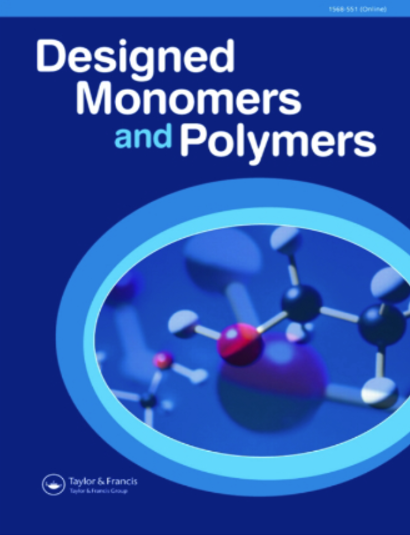Polymerization of aniline hydrochloride in reverse of microemulsion by batch and semicontinuous process using ionic and nonionic surfactants
IF 1.8
4区 化学
Q3 POLYMER SCIENCE
引用次数: 1
Abstract
ABSTRACT The polymerization of aniline hydrochloride by inverse microemulsion in a batch process and the semicontinuous process was studied as a function of the surfactant ionic and nonionic. Polymerizations were carried out at 60°C for 4 h with a yield polymer of circa 67 and 27% wt. for ionic and nonionic surfactants. The conductivity of synthesized polyaniline by the semicontinuous process is higher up to three orders of magnitude than that of the batch process for both surfactants. The calculating degree of oxidation by UV-Vis showed the relative intensities of the quinoid to benzenoid unit around one. The morphology was determined by Scanning Electron Microscopy (SEM) and observed that the formation of the different morphologies is due to the self-assembly behavior of surfactant. The diameter z-average particle size (Dz) was studied by Transmission Electron Microscopy (TEM), which determined that the diameter particle in a semicontinuous state is larger than the one produced in a batch; this is due to the control of monomer addition in the system. These findings suggest that the polymerization process and the type of surfactant influence the properties of polyaniline.离子表面活性剂和非离子表面活性剂在反相微乳液中间歇和半连续聚合盐酸苯胺
摘要研究了离子型和非离子型表面活性剂作用下,反相微乳液间歇聚合和半连续聚合苯胺盐酸盐的反应。聚合在60°C下进行4小时,离子和非离子表面活性剂的聚合物产率约为67和27%(重量)。对于两种表面活性剂,半连续工艺合成的聚苯胺的电导率都比间歇工艺高出三个数量级。UV-Vis计算的氧化度显示醌类与苯类单元的相对强度约为1。通过扫描电子显微镜(SEM)测定了表面活性剂的形貌,并观察到表面活性剂自组装行为导致了不同形貌的形成。通过透射电子显微镜(TEM)研究了直径z平均粒径(Dz),确定半连续状态下的直径颗粒大于批量生产的直径颗粒;这是由于对系统中单体添加的控制。这些发现表明,聚合过程和表面活性剂的类型会影响聚苯胺的性能。
本文章由计算机程序翻译,如有差异,请以英文原文为准。
求助全文
约1分钟内获得全文
求助全文
来源期刊

Designed Monomers and Polymers
化学-高分子科学
CiteScore
3.30
自引率
0.00%
发文量
28
审稿时长
2.1 months
期刊介绍:
Designed Monomers and Polymers ( DMP) publishes prompt peer-reviewed papers and short topical reviews on all areas of macromolecular design and applications. Emphasis is placed on the preparations of new monomers, including characterization and applications. Experiments should be presented in sufficient detail (including specific observations, precautionary notes, use of new materials, techniques, and their possible problems) that they could be reproduced by any researcher wishing to repeat the work.
The journal also includes macromolecular design of polymeric materials (such as polymeric biomaterials, biomedical polymers, etc.) with medical applications.
DMP provides an interface between organic and polymer chemistries and aims to bridge the gap between monomer synthesis and the design of new polymers. Submssions are invited in the areas including, but not limited to:
-macromolecular science, initiators, macroinitiators for macromolecular design
-kinetics, mechanism and modelling aspects of polymerization
-new methods of synthesis of known monomers
-new monomers (must show evidence for polymerization, e.g. polycondensation, sequential combination, oxidative coupling, radiation, plasma polymerization)
-functional prepolymers of various architectures such as hyperbranched polymers, telechelic polymers, macromonomers, or dendrimers
-new polymeric materials with biomedical applications
 求助内容:
求助内容: 应助结果提醒方式:
应助结果提醒方式:


